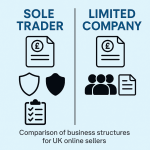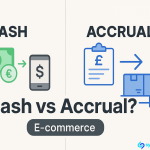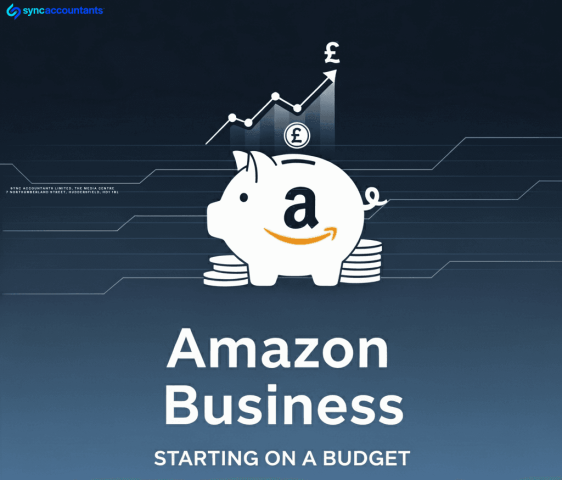
Sole trader vs limited company UK e-commerce (2025/26): what’s best for your online shop?
August 28, 2025
Cash vs Accrual Accounting for E-commerce: Which Method Fits Your Store?
September 11, 2025How much money to start an Amazon business is the question clients ask us most. The realistic answer: it depends on what you sell, how you fulfil orders (FBA vs. FBM), and how quickly you want to scale. Below is a practical, accountant-approved budget you can adapt to your goals—plus the latest on Amazon fees and UK VAT.
Core Amazon Costs You’ll Pay
- Selling plan: Individual (pay-per-sale) or Professional (flat monthly). See UK pricing.
- Referral fee: A % of the total sale price (varies by category). Check the ranges on Amazon’s UK pricing page.
- FBA (optional): Fulfilment, storage and other programme fees if Amazon ships for you. Use the fee/revenue calculator before you price.
- Other costs: Inventory, shipping to Amazon (if FBA), barcodes/packaging, listing content, launch ads, and accounting/compliance.
Typical Startup Budgets (UK Sellers)
These example budgets assume a private-label or branded product. If you’re reselling/retail-arbitrage, the low end may be lower; brand-building usually sits mid–to–high range.
1) Lean Test (FBM or very light FBA): £500–£1,500
- Amazon plan (1–2 months): £25 + VAT/month (Professional) or 75p per sale (Individual)
- Starter inventory (small batch): £300–£900
- Listing content & photos (DIY or budget): £50–£200
- Ads/test promos: £100–£200
- Basic packaging/barcodes/misc: £50–£200
Best for validating demand fast without big cash tied up.
2) Balanced Launch (FBA): £2,500–£5,000
- Amazon plan (3 months): £75 + VAT (Professional)
- Inventory (2–3 months’ cover): £1,500–£3,000
- Freight to Amazon & prep: £200–£600
- Branding, photography & A+ content: £300–£800
- Ads & product sampling (launch phase): £400–£900
- Contingency (returns, re-orders, fee variance): £200–£400
3) Brand-Build Launch (FBA + faster scale): £7,500–£15,000+
- Inventory (3–4 months’ cover, multiple SKUs/variants): £4,000–£10,000+
- Pro creative (studio photography/video, A+ & Storefront): £800–£2,000
- Ads (PPC + external): £1,000–£2,000+ in first 60–90 days
- Trademark/IP, packaging upgrades, QA: £700–£1,500+
- Working capital buffer for re-orders: £1,000–£2,000+
What Drives the Budget Up (or Down)?
- Product economics: Higher COGS and bulky items raise freight and FBA fees.
- Fulfilment method: FBA improves conversion and Prime access but adds fulfilment/storage fees; FBM reduces fees but adds your time/ops.
- Advertising pace: Faster ranking needs more PPC budget early on.
- Compliance & insurance: Some categories need testing or certifications; Amazon also requires commercial liability insurance based on marketplace rules.
Tax & Compliance Watch-outs (UK)
- VAT: Track taxable turnover—if you cross the current registration threshold, you must register and charge/submit VAT. See the latest threshold on GOV.UK.
- Bookkeeping: Reconcile Amazon disbursements, fee detail and ad spend; map FBA/FBM fees to your chart of accounts so margins stay visible.
- Pricing: Use the FBA calculator and include referral + fulfilment + VAT in your landed price model.
Quick Checklist: Keep Costs Under Control
- Validate demand with a small test (keywords, competitor reviews, small batch).
- Price backwards from target margin after all Amazon fees and VAT.
- Keep 60–90 days of stock to avoid stockouts and excess storage charges.
- Monitor fee updates—FBA fulfilment/storage rules change periodically.
- Reinvest early profits into re-orders and better creative that lifts conversion.
So… how much money to start an Amazon business?
For most UK starters, a sensible answer is £2,500–£5,000 for a solid FBA launch, with lean tests possible around £500–£1,500 and brand-first launches from £7,500+. Your exact figure turns on product size/weight, category referral fee, fulfilment route and speed of growth. If you want help building a launch budget and cash-flow plan, our ecommerce accounting team can model scenarios with your real numbers.
Bottom line: Decide your entry point, run the fees in the calculator, and build a cash buffer. That’s the smartest path to profit on Amazon.
